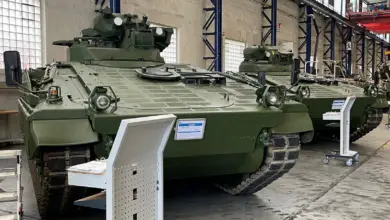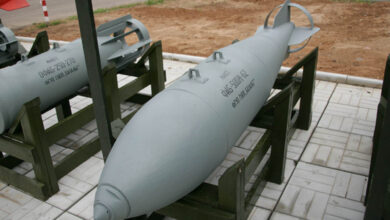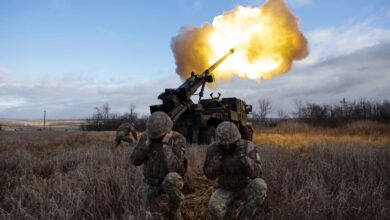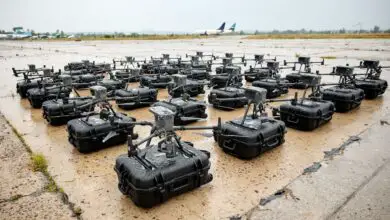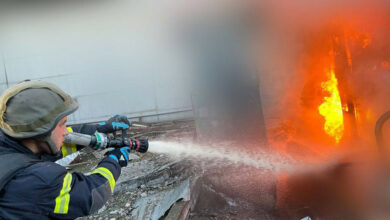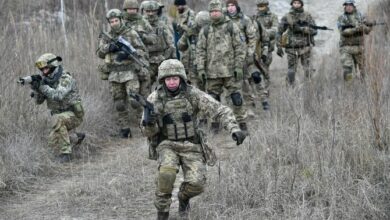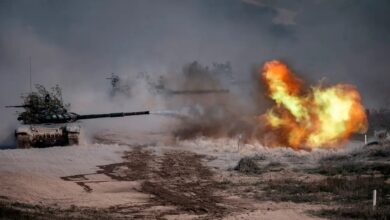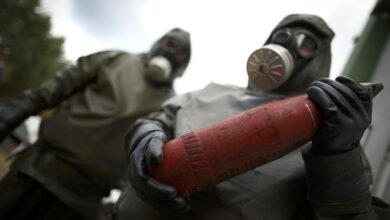
Having spent two years helping Ukraine reform its defense establishment, conducting field research in Georgia to study the 2008 Russia-Georgia war, and field research in the Baltics to study their efforts to deter Russian aggression, I had my own thoughts on how a Russian invasion might play out.
In the first week of the war, much has gone as expected, but there have been some surprises as well.
Justification for War
Russia attempted to justify its previous invasions of Georgia and Ukraine under the international norm of the responsibility to protect, couching the invasions as protecting South Ossetians, Crimeans, and ethnic Russians from Ukrainian (or Georgian) genocide.
Thus, it was expected that Russia would attempt to justify the invasion of Ukraine similarly, no matter how uncredible the claim was.
This has played out as expected. The Biden administration warned against false flag operations, taking that option off the table for Vladimir Putin.

Next, based on ceasefire violations as reported by the Organization for Security and Cooperation in Europe, it appears that Russia directed separatists in the self-declared republics to dramatically increase artillery, sniper, and other attacks along to line of contact (the cease fire line in the Donbas) to provoke a Ukrainian response.
When Ukraine failed to take the bait, Putin simply recognized the independence of the Donetsk and Luhansk regions so that he could justify the invasion as coming to the defense of sovereign territories.
At the same time, Putin claimed that Ukraine was carrying out “genocide” against Russian speakers, despite no evidence for the claim.
Russian Territorial Gains
Ukraine had to defend against 190,000 Russian forces staged along the 1,898-mile land border that it shares with Russia and Belarus (from which Russia also staged troops to launch its attack) without knowing when or where Russia would concentrate its attack.
This would be the equivalent of Canada defending against an attack from the United States along the western border from Minnesota to Washington (1,874 miles).
It would be unrealistic to expect Ukraine to hold Russian forces at the border and the line of contact.
As it did in its previous invasions, Russia was expected to use cyber and electronic warfare before the invasion to cripple Ukraine’s command and control networks and then use air, missile, artillery, and rocket attacks to support its ground assault.
This has played out mostly as expected, but there have been some surprises.
Russia’s cyber and electronic warfare have been less effective than anticipated. And while Russia has made advances into Ukraine, it is not where I would have expected.

Not knowing Putin’s strategic goals, I thought Russia might limit its invasion to the Donbas region with the goal of expanding the self-proclaimed Donetsk People’s Republic and Luhansk People’s Republic to include the entire Oblasts.
This would allow Putin to demonstrate the West’s weakness to prevent an invasion while at the same time provoke a much more muted Western response, since some nations, such as Germany, who have generally eschewed sanctioning Russia, would use the fact that the conflict was constrained to the Donbas region to justify a tepid response.
This has not played out as I expected as Russia’s greatest advances have been in the north and south, with little expansion in the east.
Stiff Ukrainian Resistance
In 2014, Ukraine was completely unprepared for its fight against Russian-led separatists in the Donbas. Its military was described as being in a “decrepit” state after being hollowed out by decades of corruption. Yet, the nation displayed an exceptional will to fight, even if its capability was lacking.
In the past eight years, Ukraine has made significant reforms to its defense establishment while at the same time gaining critical weapons systems such as Javelin anti-tank missiles.
With reforms to how it organizes, trains, educates, and equips its force, I expected Ukrainian forces to outperform the Russians at the tactical level, as the Georgians often did in their war.
This appears to be playing out as expected, with US officials assessing that Russia is facing stiffer resistance than expected.
The Air Campaign
I expected Russia’s air defenses would force Ukraine would ground its air force. Yet, surprisingly, Ukraine’s Air Force has maintained the ability, at least at some level, to fly and engage Russian targets. And Ukrainian airspace is still reported as being contested despite claims by Russia that it has claimed air superiority.
Likewise, I expected Ukrainian air defenses, aided by the recent transfer of Stinger Missiles from Lithuania, to inflict enough losses in the opening days of the war to cause Russia to significantly reduce its number of sorties.
Stingers ✅ Thanks to the @LithuanianGovt, Lithuanian people&personally to great friend of 🇺🇦 @a_anusauskas for the aid! Ukrainian & Lithuanian relations are very close&have lasted for many centuries. I appreciate our centuries-old friendship&strength support of each other!🇺🇦🤝🇱🇹 pic.twitter.com/zf8sNj9Oe7
— Oleksii Reznikov (@oleksiireznikov) February 13, 2022
In the five-day 2008 war, Georgia shot down as many as 22 Russian aircraft, which caused Russia to decrease its number of sorties.
Thus, I expected Russia would once again fly its aircraft until taking an unacceptable number of losses, at which point it would significantly reduce its number of sorties and rely, instead, on rockets and missiles.
Ukraine has claimed to have shot down 27 warplanes and 26 helicopters, though it is hard to get accurate reporting.
Regardless, it appears that airspace remains contested, and losses will continue to mount as long as sorties are flown.
Sanctions
Sanctions following the 2014 invasion were relatively modest. The fact that Russia is scheduled to host world championships in volleyball, shooting, and hockey in 2022, only six years after its illegal annexation of Crimea and continued support to separatists in Ukraine’s east, is a testament to the relatively small price that Russia has paid for its previous invasion.
Likewise, despite its invasion of Georgia in 2008, the International Olympic Committee allowed Russia to host the 2014 Winter Olympics in Sochi that it awarded in 2007.
In the lead-up to the war, President Biden threatened that Russia would “pay a heavy price” for any invasion, so it was expected that sanctions would be swift and severe.
Yet despite having months to plan post-invasion sanctions, the sanctions proposed in the first couple days were extremely weak and accurately described by one analyst as the equivalent of taking “a peashooter to a gunfight.”

Momentum, however, has picked up recently, with the West agreeing to expel some Russian banks for the SWIFT payment systems. This has resulted in the Russian rubble tumbling by 30 percent against the dollar and the Russian central bank more than doubling its key interest rate from 9.5 to 20 percent.
Thus, less than a week in, while the war may not have unfolded as Putin expected, much of it could have been anticipated by studying his previous invasions and Ukrainian military reforms over the past six years.
While there have been some surprises to date, there will undoubtedly be many more in the coming days, weeks, or months as this unfortunate war continues to play itself out.
 Dr. Liam Collins (@LiamSCollins) is the executive director of the Viola Foundation, the executive director of the Madison Policy Forum, a senior fellow with New America, and a permanent member with the Council on Foreign Relations.
Dr. Liam Collins (@LiamSCollins) is the executive director of the Viola Foundation, the executive director of the Madison Policy Forum, a senior fellow with New America, and a permanent member with the Council on Foreign Relations.
He is co-editor of the recently released Routledge Handbook of U.S. Counterterrorism and Irregular Warfare Operations and co-editor of the forthcoming Understanding Urban Warfare.
From 2016 to 2018, Liam served as General (retired) John Abizaid’s executive officer for his Secretary of Defense appointment as the Senior Defense Advisor to Ukraine.
In that position, he met with hundreds of Ukrainian officials including their president, minister of defense, and chief of staff of the armed forces.
Within the United States, he met with numerous officials including the National Security Advisor, Secretary of Defense, senior Department of State Officials, and the House Armed Services Committee.
He has conducted field research in the Baltics and Georgia and authored numerous articles and reports. Most recently, he has conducted interviews with BBC World News and CBC News to discuss the current situation.
Liam served in the US Army for 27 years. As a career Special Forces officer, he conducted multiple operational and combat deployments to Afghanistan, Iraq, Bosnia, South America, and the Horn of Africa.
Liam retired from the military in 2019 as the founding director of the Modern War Institute and the director of the Department of Military Instruction at the United States Military Academy at West Point.
The author of dozens of articles and reports related to terrorism and conflict, Liam’s work has been cited by the Assistant to the President for Homeland Security & Counterterrorism, the White House Press Secretary, The New York Times, Associated Press, CNN, ABC News, Fox News, NPR, The Wall Street Journal and USA Today.
He holds a Bachelor of Science degree in Mechanical Engineering (Aerospace) from the United States Military Academy, a Master’s in Public Affairs, and a PhD from Princeton University’s School of Public and International Affairs.
The views and opinions expressed here are those of the author and do not necessarily reflect the editorial position of The Defense Post.
The Defense Post aims to publish a wide range of high-quality opinion and analysis from a diverse array of people – do you want to send us yours? Click here to submit an op-ed.

